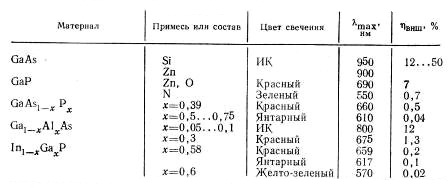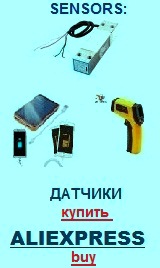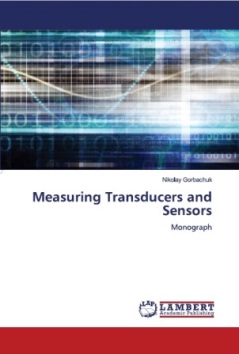Transducers, gauges, sensors - Information portal © 2011 - 2025 Use of material is possible by placing an active link

SOLID SOURCES OF RADIATION
There are two types of semiconductor radiation sources: sources of incoherent radiation - LEDs and sources of coherent radiation - lasers. Greatest practical widespread radiation sources based on p- n junction.
LEDs .
Emission occurs due to recombination of injected carriers in a part of p -n- junction ( or a part of the p - n- region adjacent to the interface of p -n- junction). Recombination occurs at the transition from the upper carriers to lower levels, while transitions can be of two types - direct (no change of momentum ) and indirect (with a change of momentum). Interband transitions between the conduction band minimum and valence band maximum radiation accompanied by effective if direct transitions, ie, the minimum and maximum are located at the same value of the wave vector k. Such transitions occur, for example, in gallium arsenide for k = 0.
In semiconductors with indirect transitions probability of interband transitions is negligible. Nevertheless, radiative recombination can effectively go through suitable impurity centers in two stages: first localization support single sign on for a relatively long time at the impurity center and then its free carrier recombination with another sign. As such centers, for example, gallium phosphide appear in donor-acceptor complexes (Zn = 0) or isoelectronic trap neutral ( N atom instead of P atoms in the lattice GaP ).
Emission wavelength at the transition from the level of support at the level of E1 E2
λ=ñ/ν = ñh/(Å2 - Å1) = 1,24/ (Åg - ΔÅ),
where λ - in microns, ΔE depth of the impurity level, eV. When recombination of ΔE = 0. In real semiconductors recombination does not occur between electrons and holes on two levels, and between electrons and holes, arranged in two groups of levels, resulting in the emission spectrum is blurred. Therefore, the above formula defines a wavelength at the peak of the emission spectrum λmax.
The main characteristic of LEDs is the internal quantum efficiency ηâíò ( ratio of the number of photons to any number of carriers injected into the base ) and external ηâíø ( ratio of the number of photons emanating from the LEDs to the total number of charge carriers flowing through it) .
To reduce lead ηâíò nonradiative recombination on structural defects and absorption of photons in the semiconductor ( self-absorption ), since the photon energy is close to Eg. The first samples of LEDs were created based on n- GaAs, p-region which was formed by the diffusion of zinc. A large number of defects in a structure arises due to the need of heavy doping of p- region (n +-p- transition) to achieve sufficient koºffitsienta injection, on the one hand , and the need for heavy doping of p- region - on the other hand, since the rate of radiative recombination is proportional to the concentration of the basic carriers in the p - region. Therefore ηâíò not exceed 1 ... 2%. Significantly greater ηâíò ( to 20-28 % ) have the most common currently LEDs created epitaxial gallium arsenide doped silicon ( p-type ) on the n- GaAs. This is due to greater perfection of the crystal structure, and the fact that the area is highly compensated silicon semiconductor emits light quanta with an energy of 1.31 ... 1.34 eV lower than Eg uncompensated gallium arsenide, which reduces self-absorption in the derivation of the radiation through the n-region.
In an even better extent these problems can be solved using heterojunctions.
Table 1 shows the basic materials currently used to create LEDs having the best record in the relevant regions of the spectrum. Hvnsh parameter depends strongly on the technology and the growth of its level can be significantly increased.
For short-wave radiation is necessary to use semiconductors with a larger band gap . However, technological problems of p -n- transitions have not yet been resolved. Therefore, one way to create short-wavelength light-emitting diodes is the use of contact metal - semiconductor, included in the opposite direction. In the initial section of avalanche impact ionization occurs with the formation of a semiconductor electron and hole recombination and which provides the appearance of radiation. Another way to get short-wavelength light-emitting diodes is the application of phosphors emitting region IR LED. Shortwave radiation is produced when the excitation of luminescence absorption of infrared radiation in the phosphor film ( anti-Stokes luminescence cooperative ). This phosphor ions are sensitizers and activators. Ion sensitizer, absorbing two photons of low energy, transmits all the energy activator ion, which emits a photon with higher energy. Using, for example, gallium arsenide LED coated with phosphor -based REM lanthanum can obtain green fluorescence brightness comparable to the brightness of LEDs based on gallium phosphide. However, the efficiency of such combined performance LEDs and always small.
LEDs are finding wide application in digital displays and lighting panels for instrumentation and output devices with a computer, as well as in optoelectronics devices. Near the time when they will be created based screens for color televisions. Compared with conventional light sources LEDs are small size, low operating voltage, high speed (up to 10 ^ -9 s ) and long service life.
References: I.M.Vikulin, V.I.Stafeev. Physics of semiconductor devices. M. - 1990
Table 1. The materials used to create LEDs:
ðóññêèé / english
Home >> Photo effects, light >> SOLID SOURCES OF RADIATION
• Information about various converters and sensors of physical quantities, parameters of various physical processes is presented.
• Electrophysical properties and effects in various electrical materials.
• Theory, experimental results, practical application

See also:
CONVERTERS, GAUGES, SENSORS
Information, news, advertising


